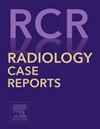Undiagnosed congenital adrenal hyperplasia in a young woman: MRI insights into complex genital malformations
Q4 Medicine
引用次数: 0
Abstract
A 23-year-old female patient was referred to the radiology department for evaluation of sexual dysfunction. A previous gynecological examination revealed clitoral hypertrophy and a vagina explorable to a depth of only 2 cm. Hormonal testing showed reduced cortisol levels, along with elevated ACTH and testosterone. Cytogenetic analysis confirmed a 46, XX karyotype; FISH testing was negative for the SRY gene. Pelvic MRI revealed clitoromegaly with evidence of corpora cavernosa forming a penis, a small prostate in the periurethral region, and a vagina that converged with the urethra, forming a common urogenital sinus. No structures suggestive of a scrotum or soft tissue indicative of testicles were observed. The uterus and ovaries appeared normal. Abdominal MRI demonstrated right adrenal hyperplasia.
Congenital adrenal hyperplasia (CAH) is a group of autosomal recessive disorders resulting from defects in adrenal steroidogenesis, with affected individuals displaying various genital malformations. MRI plays a key role in diagnosing and evaluating these complex genital malformations, both of internal and external genitalia. It aids in addressing symptoms of affected individuals, such as recurrent urinary infections, urinary retention, and sexual dysfunction, and provides preoperative imaging prior to surgical correction. MRI also enables the detection of a prostate gland in patients with CAH, serving as a valuable tool for prostate cancer screening when combined with PSA monitoring.
年轻女性未确诊的先天性肾上腺增生:MRI观察复杂的生殖器畸形
一位23岁的女性患者被转介到放射科评估性功能障碍。先前的妇科检查显示阴蒂肥大,阴道可探查深度仅为2厘米。激素测试显示皮质醇水平降低,ACTH和睾酮水平升高。细胞遗传学分析证实为46,xx核型;FISH检测SRY基因呈阴性。盆腔MRI显示阴蒂肿大,海绵体形成阴茎,尿道周围有小前列腺,阴道与尿道汇合,形成共同的泌尿生殖窦。没有观察到阴囊的结构或睾丸的软组织。子宫和卵巢显示正常。腹部MRI显示右侧肾上腺增生。先天性肾上腺增生症(CAH)是一组常染色体隐性遗传病,由肾上腺甾体生成缺陷引起,患者表现为各种生殖器畸形。MRI在诊断和评估这些复杂的生殖器畸形中起着关键作用,包括内生殖器和外生殖器。它有助于解决受影响个体的症状,如复发性尿路感染、尿潴留和性功能障碍,并在手术矫正前提供术前成像。MRI还可以检测CAH患者的前列腺,当与PSA监测相结合时,它是前列腺癌筛查的有价值的工具。
本文章由计算机程序翻译,如有差异,请以英文原文为准。
求助全文
约1分钟内获得全文
求助全文
来源期刊

Radiology Case Reports
Medicine-Radiology, Nuclear Medicine and Imaging
CiteScore
1.10
自引率
0.00%
发文量
1074
审稿时长
30 days
期刊介绍:
The content of this journal is exclusively case reports that feature diagnostic imaging. Categories in which case reports can be placed include the musculoskeletal system, spine, central nervous system, head and neck, cardiovascular, chest, gastrointestinal, genitourinary, multisystem, pediatric, emergency, women''s imaging, oncologic, normal variants, medical devices, foreign bodies, interventional radiology, nuclear medicine, molecular imaging, ultrasonography, imaging artifacts, forensic, anthropological, and medical-legal. Articles must be well-documented and include a review of the appropriate literature.
 求助内容:
求助内容: 应助结果提醒方式:
应助结果提醒方式:


